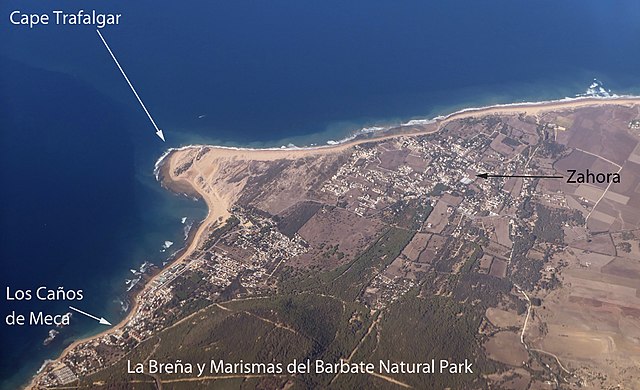Cape Trafalgar
Headland in southwest Spain From Wikipedia, the free encyclopedia
Cape Trafalgar (/trəˈfælɡər/;[1] Spanish: Cabo Trafalgar [ˈkaβo tɾafalˈɣaɾ]) is a headland in the Province of Cádiz in the southwest of Spain. The 1805 naval Battle of Trafalgar, in which the Royal Navy commanded by Admiral Horatio Nelson decisively defeated Napoleon's combined Spanish and French fleet, took place just off the cape.
Cape Trafalgar
Cabo de Trafalgar | |
|---|---|
 Cape Trafalgar lighthouse | |
Location in Andalusia | |
| Coordinates: 36°11′N 6°2′W |
Cape Trafalgar lies on the shore of the Atlantic Ocean, northwest of the Strait of Gibraltar. The International Hydrographic Organization defines the western limit of the strait and the Mediterranean Sea as a line that joins Cape Trafalgar to the north with Cape Spartel to the south.

The most prominent structure on the cape is a 34 m (112 ft) lighthouse, which totals 51 m (167 ft) above sea level), the Faro de Cabo Trafalgar, which was first illuminated on 15 July 1862.[2]
Etymology
The name is of Arabic origin, deriving either from Taraf al-Ghar (طرف الغار 'cape of the cave/laurel'),[3][4][5] or from Taraf al-Gharb (طرف الغرب 'cape of the west').[6][5] In both cases, taraf (طرف) means 'edge' or 'extremity' and refers to a promontory.[citation needed] In modern Arabic, however, the place is sometimes re-transcribed as al-Taraf al-Aghar (الطرف الأغر).[7]
Archaeology
In May 2021, 2,000-year-old Roman baths emerged from the sand dunes of Cape Trafalgar, including entire walls, windows and doors.[8]
See also
References
External links
Wikiwand in your browser!
Seamless Wikipedia browsing. On steroids.
Every time you click a link to Wikipedia, Wiktionary or Wikiquote in your browser's search results, it will show the modern Wikiwand interface.
Wikiwand extension is a five stars, simple, with minimum permission required to keep your browsing private, safe and transparent.



